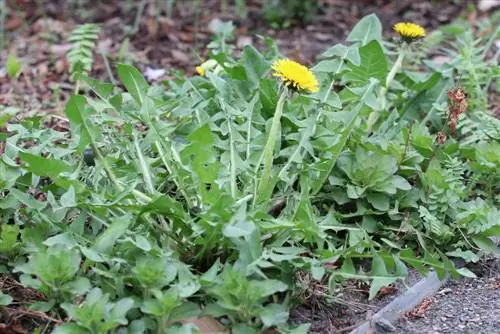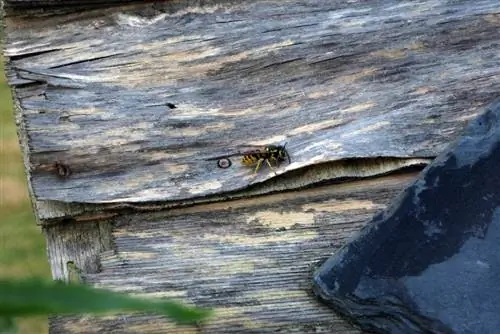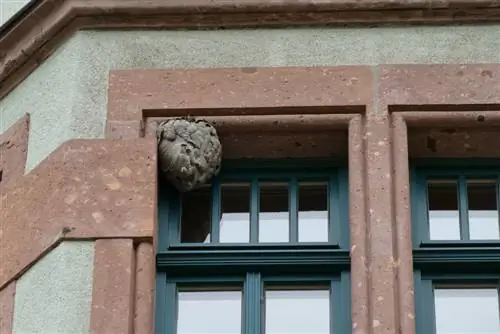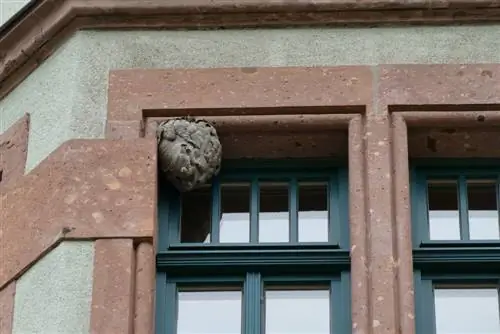- Author admin [email protected].
- Public 2023-12-17 03:39.
- Last modified 2025-01-24 12:45.
On the sausage sandwich or in the lemonade - you always need to be careful with unprotected windows and eating outside, but this is especially true if there is a wasp nest in your own garden. Many people would then like to resort to pesticides immediately or call the fire department. What is completely forgotten is that the insects do a good job and are not nearly as dangerous as their reputation suggests. Moving or even destroying the nest is therefore only sensible and permitted in exceptional cases. However, there are alternatives.
Identifying earth wasps
Earth wasps as such do not exist, but wasps that build their nest underground do. However, they are not alone. Bumblebees and bees also seek refuge here. Holes in the lawn or soil are therefore not immediately a cause for concern or clearly attributable to wasps. This requires a little more observation. In addition, not all wasps live in states. Some are also extremely loners and therefore live solitary lives. In order to identify a nest in the ground with certainty as being inhabited by a colony of wasps, the holes themselves should first be assessed. If these have a large diameter and are clearly visible, this is already the first sign. There will also be several holes in the ground within a narrow radius. Another indication is the arrival of a large number of wasps at dusk. However, if you can only observe in the morning, you should be able to see a series of excursions. The common departure usually occurs when the sun slowly warms the earth. Even then, you have to look closely. If the insects are clear black and yellow and have no hair, they are wasps. However, with gentler color contrasts, such as brown-yellow, or velvety hair, bees and bumblebees are the more likely residents. Even if it is clearly an earth wasp nest, control is not always necessary or even legal.
Nature conservation
Wasps are now protected and cannot be removed without good reason. This is not the case if the insects are perceived as a nuisance or are met with great fear. It is therefore forbidden to destroy or even move nests without permission. Even the fire department, which has been helpful for a long time, is no longer allowed to intervene. Anyone who ignores this and destroys earth wasp nests themselves must expect high fines.
Tip:
If the nest poses a danger, for example because of allergies, the nature conservation association of the respective country should be notified. The fire department can provide information about this. But a pest controller, beekeeper or an online search can also quickly produce the necessary contact details.
Wasps as beneficial insects
Wasps especially need plenty of protein in spring and the first half of summer to provide for their offspring. They are therefore usually not after jam and the like, but rather sausage and meat. Apart from that, mainly on other insects. They therefore effectively keep pests in the garden under control. In this way, they protect plants, wallets and the environment because, as natural predators of harmful insects, they often make the use of chemical insecticides unnecessary. So there are also advantages to having a wasp nest in the garden.
Implementation and elimination
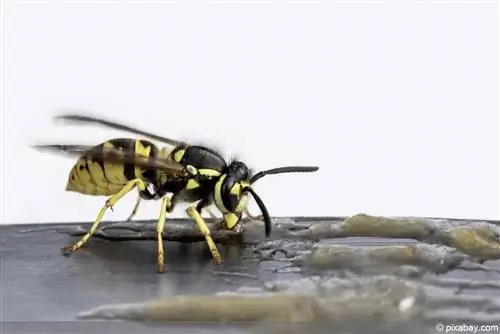
If moving the earth wasp nest has been approved, you should under no circumstances attempt this task yourself. Laypeople simply lack the necessary knowledge and experience to carry out the measure without endangering themselves and others. Instead, a pest controller, beekeeper or the nature conservation association should be commissioned to do this. Although this is associated with costs, it is the only safe option. The expenses are kept to a very manageable level, especially when it comes to resettlement by the nature conservation association of the respective federal state. However, it is cheaper if the exact position of the earth nest is already known - this eliminates the need for lengthy searches. This also and especially applies when using a pest controller. Destroying the earth wasp nest is only advisable if it is not possible to relocate the underground burrow but the danger posed by this is very high.
Hedging
Instead of getting rid of the earth wasps - be it to exploit their useful properties or because moving them is not possible - the nest can be secured. This procedure also makes sense to bridge the time until the transfer. The following instructions show what such securing of the earth wasp nest can look like:
- Place four sturdy sticks or thin square pieces of wood into the ground at a generous distance from the holes in the earth wasp nest.
- Draw close-meshed mesh wire or a solid net around these rods, which serve as cornerstones. The material chosen should of course have meshes large enough for the wasps to just fly or climb through.
- As a cover, cover or place the same material on top and attach it to the already standing frame.
- Additional flags in bright colors can be attached for better visibility.
- When setting it up, you should of course proceed with caution and consideration so as not to scare the wasps. Children and pets must be kept away during this time. In addition, appropriate protective clothing, as known from beekeepers, is useful.
This cage prevents children and pets from accidentally landing on the earth wasp nest while playing. This reduces the risk of stings. On the other hand, it slows down the trip a little if the wasps are startled and start a defensive attack. Startling is another important point that must be taken into account when there is a wasp nest in the ground. It is important to avoid shocks, vibrations or even digging in the immediate vicinity of the nest. Since the beneficial insects will protect their offspring, they would defend the nest with bites if necessary.
Tip:
As an alternative to the cage-like structure, the earth wasp nest can also be demarcated using long boards wrapped in mesh wire. These are leaned against each other at the top edges, like a campfire, and then fixed with the wire.
Protection
With earth wasp nests, it is often enough to simply install a barrier as described above or avoid the location. Since the wasps only use the underground nest for a year and then move on, even this doesn't have to be a permanent solution. In addition, there are some options for protection:
- Secure windows and doors with fly screens, this doesn't just keep wasps out
- Place strong-smelling plants or essential oils, such as lavender, mint and citronella, near windows and throughout the garden - these only have a limited effect on existing wasp nests, but they prevent further wasps from settling
- When eating outside, cover all food and drinks so that the wasps are not attracted in the first place
- As a distraction and as additional protection during picnics and afternoon coffee, overripe fruit can be placed at a distance of around five meters
- Grapes and bananas are particularly attractive, but ham doesn't hurt either
- When spending longer periods outdoors, avoid sweet or strong-smelling perfumes, lotions, fabric softeners and the like
- Teach pets early on not to snap at wasps and to stay away from them if possible
- If necessary, use animal-friendly repellent sprays, wasp pillows and candles based on essential oils for defense purposes
Conclusion
An earth wasp nest is not a reason to panic, but actually speaks for the goodness of your own garden and has some advantages. Nevertheless, some measures and means can and should be taken to keep the risk of stings as low as possible.


